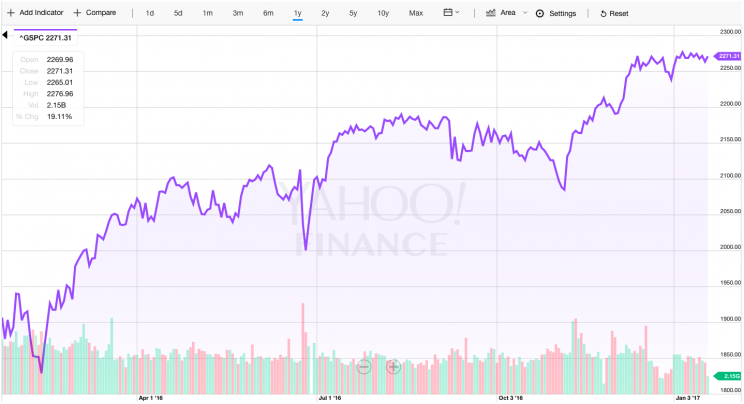Trump's first week — What you need to know in markets this week
Well, it happened.
On Friday, Donald J. Trump was sworn in as the 45th President of the United States.
What happens now, of course, is uncertain. But the exhaustion of the campaign and the uncertainty of the period after the election is now over. The job of governing has begun.
In markets last week, stocks did what they’ve done now for more than a month: not much. The S&P 500 extended its streak of days without a 1% down move to 69, the longest of the current bull market.

The market move after Trump’s election was swift, and it was up. Corporate earnings season is just getting underway, and the first bits of hard data to reflect the business and consumer optimism we saw perk up after the election will start to roll in.
What Trump’s America brings to markets and the economy will soon start to take shape.
Economic calendar
Monday: No major economic data released.
Tuesday: Markit preliminary US manufacturing PMI (54.5 expected; 54.3 previously); Existing home sales, December (-2% expected; +0.7% previously); Richmond Fed manufacturing, January (6 expected; 8 previously)
Wednesday: FHFA home price index, November (+0.3% expected; +0.4% previously)
Thursday: Initial jobless claims (245,000 expected; 234,000 previously); Whole sales inventories, December (+0.1% expected, +1% previously); Markit preliminary US services PMI (54.5 expected; 53.9 previously); New home sales, December (-1.2% expected; +5.2% previously)
Friday: Fourth quarter GDP, first estimate (+2.2% expected: +3.5% previously); Durable goods orders, December (+2.6% expected; -4.5% previously); University of Michigan consumer sentiment, January (98.1 expected; 98.1 previously)
Disappointment looms
When Donald Trump was elected president, markets initially sold off.
Then, within hours, the Trump rally was ignited. A few weeks later, we were talking about Dow 20,000. But since the middle of December, stocks have gone nowhere. And Inauguration Day was no different.
Stocks opened Friday higher before selling off a bit after Trump’s swearing in. Buy the rumor, sell the news. But all told, the market reaction to the first hours of President Trump was, well, not much of a reaction.
Most of the Trump rally and optimism — political, economic, or otherwise — surrounding the Trump administration has been, in part, based on the idea there’s a “pivot” coming, or a new, more pragmatic, less volatile, more vanilla version of Trump soon to be unveiled.
But read the text of Trump’s inauguration speech, though, and it becomes clear that there is no pivot. Trump is not a traditional politician, and he is not a traditional Republican.

Trump talked on Friday not of building a wall between the US and Mexico, but of protecting our borders, “from the ravages of other countries making our products, stealing our companies and destroying our jobs.”
Trump said, “We will follow two simple rules: buy American, and hire American.”
Adding that, “We will seek friendship and goodwill with the nations of the world, but we do so with the understanding that it is the right of all nations to put their own interests first. We do not seek to impose our way of life on anyone, but rather to let it shine as an example.”
Trump, in other words, is no neoliberal or neoconservative. He is Donald Trump.
“Since the US election, a broadly shared view is that a combination of tax cuts, infrastructure spending and lighter regulation will create above-trend growth,” writes Ethan Harris, an economist at Bank of America Merrill Lynch.
“Moreover, even though these policies have not been enacted yet, they expect growth to immediately move to a higher growth plane as animal spirits kick in.”

But Harris thinks there are three negatives that could come up quickly markets aren’t focusing enough on. Tax reform is likely to be slow, a big infrastructure package seems unlikely to win Republican support, and trade tensions stand to be a major problem for the “animal spirits” that are supposed to stoke a big economic turnaround.
Shortly after Trump’s swearing in, the contents of the White House’s website were updated and showed an outline of what Trump hopes to accomplish while in office.
Trump states an ambition of creating 25 million jobs in the US and getting GDP back to 4%. This is not a campaign goal: this is policy. Trump also talks cutting taxes for all Americans, cutting regulations, and negotiating new trade deals.
“President Trump is committed to renegotiating NAFTA,” the site reads. “If our partners refuse a renegotiation that gives American workers a fair deal, then the President will give notice of the United States’ intent to withdraw from NAFTA.”
Again, there is no pivot.
“The bottom line,” Harris writes, “is that we think some kind of soft patch is likely in the first half as investors and business people reassess the size and timing of the fiscal stimulus and worry about rising trade tensions.”
Trump is and will likely remain hostile to trade, hostile to globalization, and create a new economic and political reality not just for the US but the world.
—
Myles Udland is a writer at Yahoo Finance. Follow him on Twitter @MylesUdland
Read more from Myles here:

 Yahoo Finance
Yahoo Finance 
